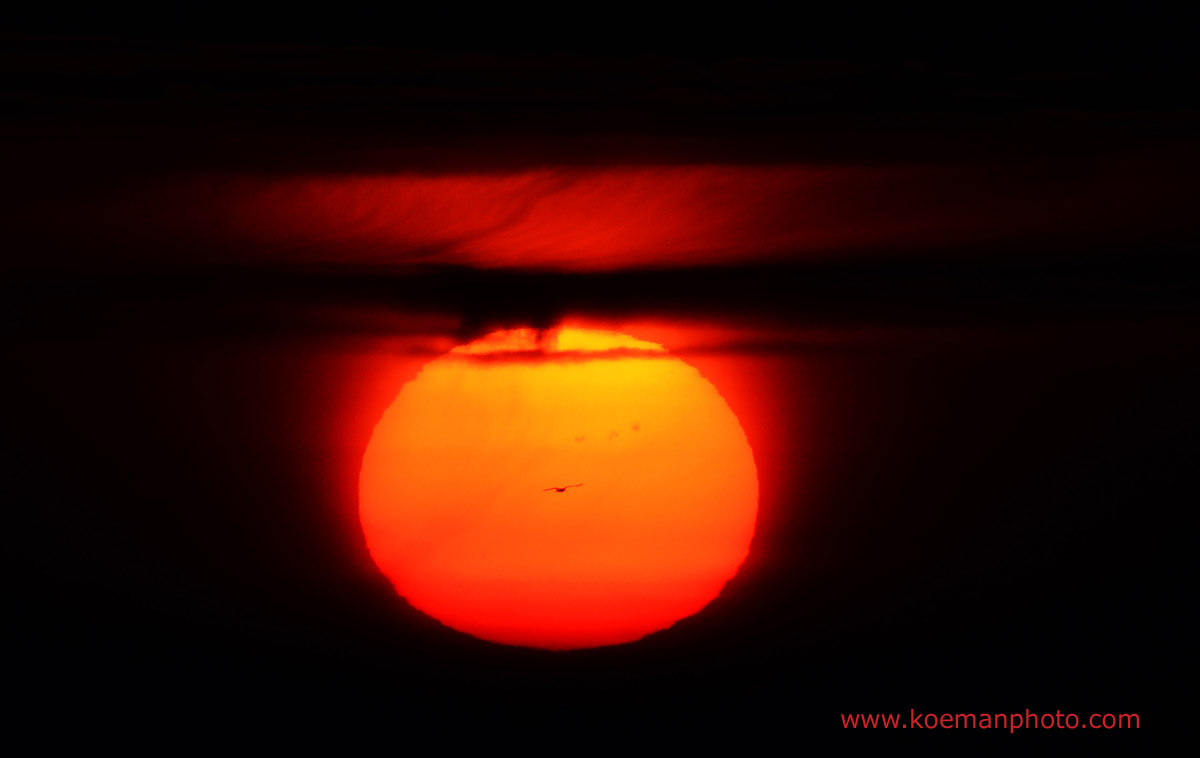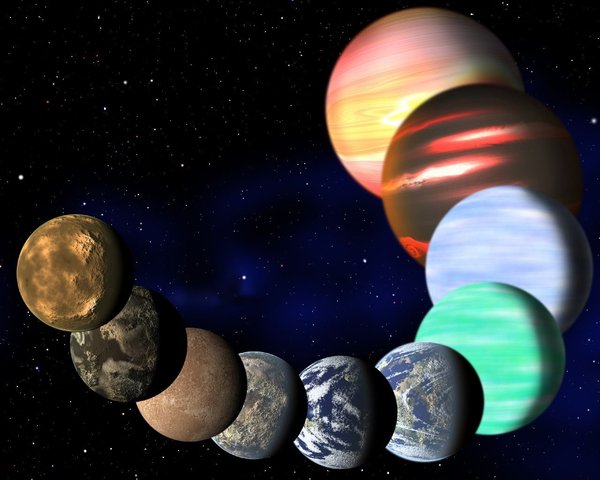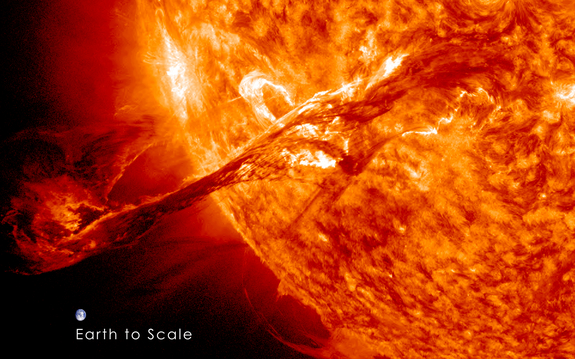The Sun we love – but it can turn — like a bad temper.
 This event is called a prominence, and it happens when huge amounts of energy stored in the Sun’s magnetic field is eruptively released. Loops of magnetic field lines pierce through the Sun’s surface, their bases forming sunspots. Each spot is like a magnet’s north or south pole, and the loop connecting them can contain a lot of energy. I mean a lot: big ones can explode with the equivalent of billions of nuclear weapons. If the lines get tangled or the spots get too close together, it’s like shorting out an electric circuit. The lines snap, the energy is released, and mayhem occurs.
This event is called a prominence, and it happens when huge amounts of energy stored in the Sun’s magnetic field is eruptively released. Loops of magnetic field lines pierce through the Sun’s surface, their bases forming sunspots. Each spot is like a magnet’s north or south pole, and the loop connecting them can contain a lot of energy. I mean a lot: big ones can explode with the equivalent of billions of nuclear weapons. If the lines get tangled or the spots get too close together, it’s like shorting out an electric circuit. The lines snap, the energy is released, and mayhem occurs.
In this case, it was a relatively mild event. Only a few million tons of hydrogen were blasted a hundred thousand kilometers up from the Sun’s surface against its fierce gravity, and the explosion was probably only the same as a paltry few million megaton-class bombs. No biggie.
The images to make the animation were taken by NASA’s Solar Dynamics Observatory, which stares at the Sun 24 hours a day. It can see well out into the far ultraviolet part of the spectrum, where activity like this is more obvious (in this case, the images were at a wavelength of 30.4 nanometers).
The Sun is approaching the peak of its 11-year magnetic cycle, which should mean more sunspots and more activity. However, it’s not easy to predict what will actually happen; it may be a smaller peak than usual, or it may be bigger. We need our eyes on the Sun like SDO to let us know what’s happening! Big explosions create waves of subatomic particles that can scream across space; when they reach Earth they can damage our satellites and trigger blackouts here on Earth, causing billions of dollars in damage.
Literally, space exploration and our knowledge of astronomy and physics can help save money, property, and our modern technical civilization. There’s a thought to start your new year off right!
Moon has changed
From year to year, the Moon never
seems to change. Craters and other
formations appear to be permanent
now, but the Moon didn’t always look
like this.
Thanks to NASA’s Lunar Reconnaissance
Orbiter, we now have a better look at
some of the Moon’s history.
Space– 461 potential New Planets– Great but they are among us …
 By Irene Klotz, Reuters
By Irene Klotz, Reuters
NASA’s Kepler space telescope has uncovered another 461 potential new planets, most of which are the size of Earth or a few times larger, scientists said Monday.
The announcement brings Kepler’s head count to 2,740 candidate new worlds, 105 of which have been confirmed.
“Two years ago we had around 1,200 candidate planet objects. A year later, we added a significant number of new objects and saw the trend of huge numbers of very small planets … twice the size of Earth and smaller,” Kepler astronomer Christopher Burke told a news conference webcast from the American Astronomical Society conference in Long Beach, Calif.
——————————————————————————–
With the addition of 461 new candidate planets, collected over 22 months of Kepler telescope observations, the proliferation of smaller planets continues.
Advertise | AdChoicesThe new targets include KOI-172.02, a planet candidate that’s about 1.5 times bigger than Earth and circles its sunlike parent star in a 242-day orbit. At that distance, liquid water, believed to be necessary for life, could exist on the potential planet’s surface.
A Jupiter-sized planet known as PH2 b, discovered by citizen scientists participating in the Planet Hunters project, lies within its parent star’s habitable zone.
“This is just a first step toward finding a habitable world elsewhere,” Ji Wang, a postdoctoral researcher at Yale University and the lead author of a paper about PH2 b, said in a news release. “Any moon around this newly discovered, Jupiter-sized planet might be habitable. It’s very similar to what was depicted in the movie ‘Avatar’ — the habitable moon Pandora around a giant planet, Polyphemus.”
The Planet Hunters group also reported finding 42 candidate planets, including 15 that lie within habitable zones.
The goal of the Kepler mission, which began in 2009, is to determine how many stars in the Milky Way galaxy have an Earth-sized planet orbiting in so-called habitable zones, where water can exist on its surface.
“You need very specific conditions to have liquid water. You can’t have your planet too close to your star where it’s too hot. You can’t have it too far away for the planet conditions to be too cold. We’re trying to find these planets in this very specific habitable zone,” said Burke, who is with the SETI Institute in Mountain View, Calif.
The Kepler telescope works by tracking slight decreases in the amount of light coming from 160,000 target stars caused by a planet or planets passing by, or transiting, relative to the telescope’s point of view.
Earth-sized planets located about where Earth orbits the sun would take 365 days to circle their parent star. Those located closer, in Mercury-type 88-day orbits, transit more frequently. Scientists need at least two and preferably three or more cycles to determine whether an apparent transit is real or some other phenomena.
The Kepler roster also boosts the number of multiplanet systems. Of the 2,740 objects, 299 are in dual-planet systems, 112 are in triplets, 44 are part of four-planet systems, 11 systems have five planets and one system has six planets.
Advertise | AdChoicesMore about the planet quest:
•Our galaxy has at least 17 billion alien Earths
•’Exocomets’ common across the Milky Way
•Alien planets face danger from double-star systems
•Cosmic Log archive on the planet search
This report includes
Crop Circles – a fair consideration – from the Main Stream Media.
Solar Beauty — from Jankoeman.com
href=”https://truthseekerforum.com/wp-content/uploads/2013/01/Jan-Koeman-7.jpg”> Note a couple of things — bird in the center of the Sun– and the two Sunspots facing the earth to the right and above the bird — It is possible these sunspot could turn deadly and birth a X- flare .. and strike the earth.
Note a couple of things — bird in the center of the Sun– and the two Sunspots facing the earth to the right and above the bird — It is possible these sunspot could turn deadly and birth a X- flare .. and strike the earth.
The Closest Pass since we started to track —- Asteroid– from ForbiddenknowledgeTV.com
Scientists say an asteroid named
2012 DA14 will pass close enough
to pass between Earth and the satellites
orbiting above the planet. This will be
the closest pass of an asteroid since
scientists began tracking them.
In another mainstream news segment
about this story broadcast nearly a year
ago, anchor, Brian Williams wrapped it
up by saying that although it is not
believed that this asteroid will impact
the Earth, “Experts say that there is
nothing wrong with making sure your
affairs are in order”
Video (about 2 and a half mins):
Truth – Cosmic Mission – Is it all True Series # 265
 I have debated, mostly with myself, what the most important universal concept is. Universal, meaning important to every different type of being that inhabits this world and all other worlds in our vast universe. And I am also throwing in the dimensional layers that exist, which could be maybe 10 or 12 dimensions. So the math on this is amazing, at the very least millions of different beings. I have narrowed it down to two important concepts, Love and Truth. I know many of you reading this would pick Love as the most important concept in the universe, and I agree it’s an amazing choice. But I say without Truth, Love has no legs. And Truth does not need Love to exist. I believe there are places in the universe where Love does not exist, sad places, but places where beings do function and are lost to the concept of Love.
I have debated, mostly with myself, what the most important universal concept is. Universal, meaning important to every different type of being that inhabits this world and all other worlds in our vast universe. And I am also throwing in the dimensional layers that exist, which could be maybe 10 or 12 dimensions. So the math on this is amazing, at the very least millions of different beings. I have narrowed it down to two important concepts, Love and Truth. I know many of you reading this would pick Love as the most important concept in the universe, and I agree it’s an amazing choice. But I say without Truth, Love has no legs. And Truth does not need Love to exist. I believe there are places in the universe where Love does not exist, sad places, but places where beings do function and are lost to the concept of Love.
Now Truth on the other hand, is essential, for it is the binding force that holds advanced civilizations/realms together. Once Truth is gone the civilization is also gone. I have for most of my life researched in the area of abductees and contactees and have concluded from those interviews several interesting things such as, finding the Truth is a cosmic mission. There are beings whose only mission is to travel the universe to find the basic truths, both small and large.
A pure Truth is a very difficult thing to find. It is like looking for a golden ring dropped in the vast muddy Mississippi. But once the golden ring of Truth is found, it carries the greatest pure knowledge, that knowing it can move mountains. For our civilization to survive the coming crisis we must search for the pure Truths and not be swayed by lies and part truths, nothing less than the absolute will do here.
Sleep tight, I consider myself a Truthseeker; my journey is hard and long, but the golden ring is always out there to find.
MWiz
Reaction Engine in our future —– airplane directly into space.
WOW cool Stuff

